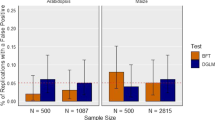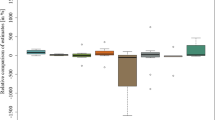Abstract
Quantitative trait locus (QTL) studies in plants frequently employ phenotypic data on a population of lines (doubled haploid lines, recombinant inbred lines, etc.) tested in multiple environments. An important feature of such data is the genetic correlation among observations on the same genotype in different environments. Detection of QTL-by-environment interaction requires tests which take this correlation into account. In this article, a comparison was made of the properties of several such tests by means of simulation. The results indicate that a split-plot analysis of variance (anova), being an approximate method, tends to be too liberal under departures from the Huynh-Feldt condition. A standard two-way anova, which ignores genetic correlation, yields inappropriate tests and should be avoided. In contrast, mixed model approaches as well as univariate and multivariate repeated-measures anova yield valid results. This supports the use of a flexible mixed model framework in more complex settings, which are difficult to tackle by repeated-measures anova.
Similar content being viewed by others
References
Churchill GA, Doerge RW (1994) Empirical threshold values for quantitative trait mapping. Genetics 138:963–971
Davies RB (2002) Hypothesis testing when a nuisance parameter is present only under the alternative: linear model case. Biometrika 89:484–489
Eckermann PJ, Verbyla AP, Cullis BR, Thompson R (2001) The analysis of quantitative traits in wheat mapping populations. Aust J Agric Res 52:1195–1206
Falconer DS, Mackay TFC (2001) Introduction to quantitative genetics, 4th edn. Pearson Education, Harlow
Geisser S, Greenhouse SW (1958) An extension of Box’s results on the use of the F-distribution in multivariate analysis. Ann Math Stat 29:885–891
Haley CS, Knott SA (1992) A simple regression method for mapping quantitative trait loci in line crosses using flanking markers. Heredity 69:315–324
Huynh H (1978) Some approximate tests for repeated measurement designs. Psychometrika 43:161–175
Huynh H, Feldt LS (1976) Estimation of the Box correction for degrees of freedom from sample data in randomized block and split plot designs. J Educ Stat 1:69–82
Jiang CJ, Zeng ZB (1995) Multiple trait analysis of genetic mapping for quantitative trait loci. Genetics 140:1111–1127
Kenward MG, Roger JH (1997) Small sample inference for fixed effects from restricted maximum likelihood. Biometrics 53:983–997
Lynch M, Walsh B (1998) Genetics and analysis of quantitative traits. Sinauer, Sunderland
Piepho HP (1998) Empirical best linear unbiased prediction in cultivar trials using factor analytic variance-covariance structures. Theor Appl Genet 97:195–201
Piepho HP (2000) A mixed model approach to mapping quantitative trait loci in barley on the basis of multiple environment data. Genetics 156:253–260
Piepho HP (2001) A quick method to compute approximate LOD thresholds for QTL detection. Genetics 157:425–432
Piepho HP, Pillen K (2004) Mixed modelling for QTL × environment interaction analysis. Euphytica 137:147–153
Piepho HP, Büchse A, Emrich K (2003) A hitchhiker’s guide to the mixed model analysis of randomized experiments. J Agron Crop Sci 189:310–322
Piepho HP, Büchse A, Richter C (2004) A mixed modelling approach to randomized experiments with repeated measures. J Agron Crop Sci 190:230–247
Pillen K, Zacharias A, Léon J (2003) Advanced backcross QTL analysis in barley (Hordeum vulgare L.). Theor Appl Genet 107:340–352
Rogan JC, Keselman HJ, Mendoza JL (1979) Analysis of repeated measures. Br J Math Stat Psychol 32:269–286
Tinker NA, Mather DE (1995) Methods for QTL analysis with progeny replicated in multiple environments. J Agric Genomics 1 (http://www.cabi-publishing.org/gateways/jag/index.html)
Utz HF, Melchinger AE (1996) plabqtl: a program for composite interval mapping of QTL. J Agric Genomics 1 (http://www.cabi-publishing.org/gateways/jag/index.html)
Utz HF, Melchinger AE, Schön CS (2000) Bias and sampling error of the estimated proportion of genotypic variance explained by QTL determined from experimental data in maize using cross validation with independent samples. Genetics 154:1839–1849
Verbyla AP, Eckermann PJ, Thompson R, Cullis BR (2003) The analysis of quantitative trait loci in multi-environment trials using a multiplicative mixed model. Aust J Agric Res 54:1395–1408
Winer BJ, Brown DR, Michels KM (1991) Statistical principles in experimental design, 3rd edn. McGraw-Hill, New York
Wolfinger RD (1996) Heterogeneous variance-covariance structures for repeated measures. J Agric Biol Environ Stat 1:205–230
Acknowledgements
I thank Andreas Büchse for helpful comments on earlier versions of this manuscript.
Author information
Authors and Affiliations
Corresponding author
Additional information
Communicated by H.C. Becker
This paper is dedicated to Prof. Dr. H. F. Utz on the occasion of his 65th birthday.
Rights and permissions
About this article
Cite this article
Piepho, H.P. Statistical tests for QTL and QTL-by-environment effects in segregating populations derived from line crosses. Theor Appl Genet 110, 561–566 (2005). https://doi.org/10.1007/s00122-004-1872-9
Received:
Accepted:
Published:
Issue Date:
DOI: https://doi.org/10.1007/s00122-004-1872-9




